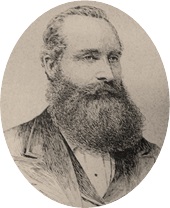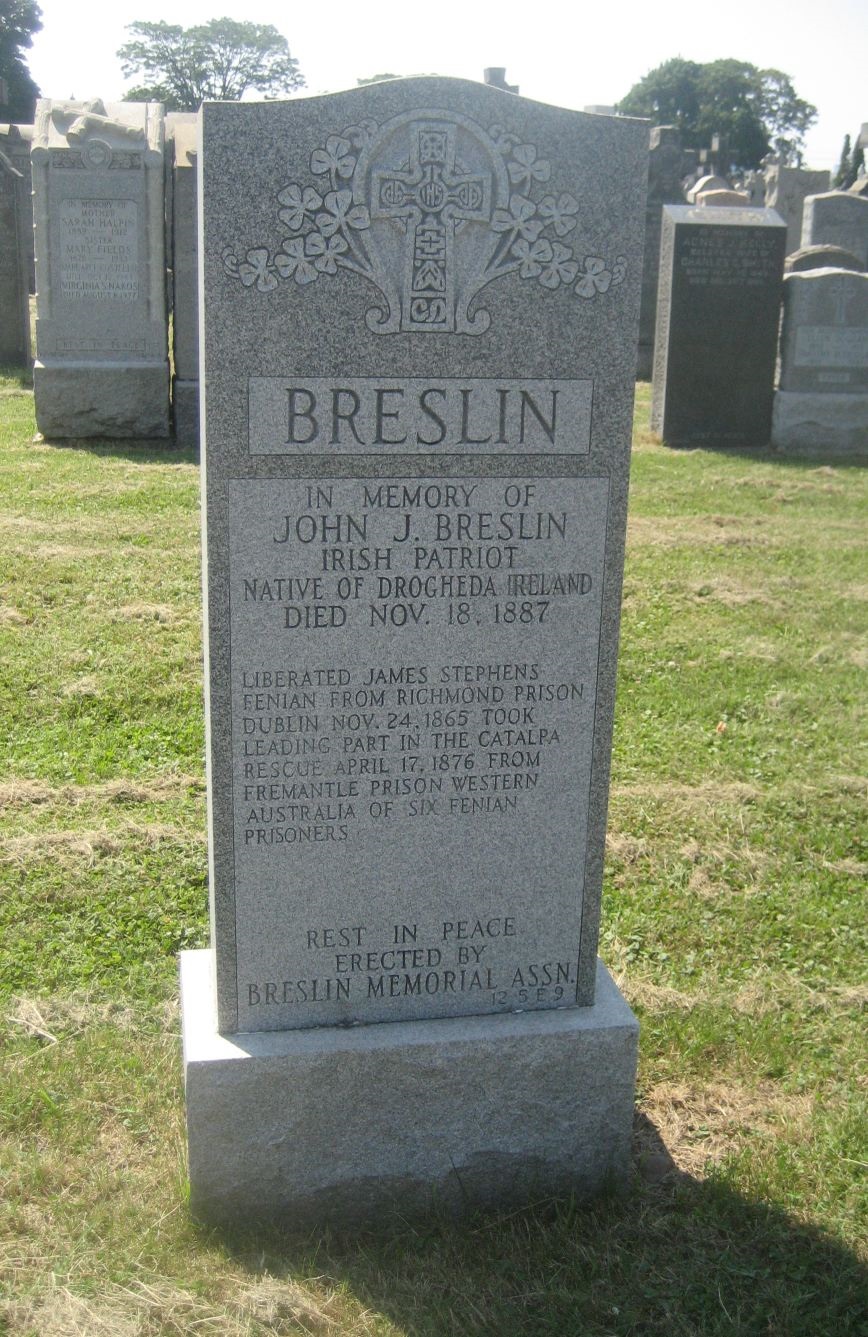|
John J.
Breslin
(1833-1887)
Fenian, Leader of the Catalpa rescue, Businessman
 Life
in Ireland Life
in Ireland
John James Breslin was born
in 1833
to Elizabeth Delaney and Ephrain Breslin in Drogheda, Co. Louth
into a family of five brothers (1) and two
sisters. Little else is known of his early life with
respect his upbringing, how his family made a living, how or
where he was educated. Nonetheless, it can be surmised
from his business acumen and successful exploits that he was a
very sophisticated and educated individual. As did he,
none of his siblings stayed on in Ireland.; all of them came to
America and took up residence in New York City.
Breslin
first came to public notice in 1865 when he made a spectacular
debut on the international stage as Hospital Superintendent at
Dublin's notorious Richmond Prison. It was here that he
arranged with a colleague, Daniel Byrne, the prison's night
watchman, to rescue the most famous of England's political
prisoners,
James Stephens, the leader of the Fenians and the founder of
‘The Irish People Newspaper’. Unknown to the
British, both Breslin and Bryne were sworn and loyal members of
the Irish Republican Brotherhood aka Fenians.
In September of 1865 The British government raided the offices
of the newspaper and arrested
Thomas Clarke Luby,
Charles Kickham and Jeremiah
O'Donovan Rossa.
All
were charged with felony-treason and sentenced to long prison
terms. Stephens was arrested a short time later and placed in a
remote wing of the heavily guarded Richmond prison for
safekeeping.
Breslin and Byrne had access to all the prison keys, making
Stephens' escape seem possible. However, the heavy security at
Richmond and Stephens' isolated location highlighted the
significant challenges they faced."
At a pre-arranged time, Stephens was escorted from his cell by
the two plotters, into the jail yard. The dark and stormy night
provided ideal conditions for the escape. Stephens climbed over
the high prison wall by rope that was thrown over the top by
outside co-conspirators and was off to freedom. With the
discovery of the escape, Byrne was immediately a suspect, but in
court the case against him lacked evidence to convict him.
Meanwhile, Breslin continued working at the hospital for several
more months until his departure to the United States where he
gave a full account of the exploit.
Life in America
Upon arrival in the US, Breslin lived in Boston for a number of
years where he worked as a freight agent at a Worcester freight
depot. After relocating to New York he worked for
Clan na Gael
as Superintendent of Experiments. From
1881 to 1885 he was business manager for the ‘Irish Nation”
newspaper owned and edited by
John Devoy.
After the newspaper
ceased operations in October of 1865, he work as a
superintendent for the New York Street Cleaning Department.
In 1873 Breslin was enlisted by John Devoy to carry out the
daring and ambitious plot to rescue six Fenians prisoners known
as ‘the
Fremantle Six’ from England's penal colony at Fremantle
Western Australia. The
men were convicted of desertion and for enlisting
fellow-Irishmen serving in the British army into the Fenian
organization. The names of the six prisoners were James
Darragh, Martin Hogan, Michael Harrington, Thomas Hassett,
Robert Cranston,
In
1875, John Devoy and Clan na Gael purchased
the Catalpa, a three-masted merchant bark, for $5,500 and
also hired
Captain Anthony to lead the rescue mission. Originally a
whaleship, the Catalpa was later converted to an open hold cargo
ship. In order to prepare it for its new mission it was restored
back to its original state as a whaleship under Anthony's
direction. Anthony recruited a crew of twenty-three, made up of
mostly of Asians and Africans. The only Fenian on board was
Denis Dugan, the ship’s carpenter, and unknown to the rest of
the crew, Devoy’s representative.
Breslin and
Thomas Desmond set sail from San Francisco for Fremantle in
Western Australia in September of 1875. After arriving there,
Breslin assumed the identity of an American businessman. He was
able to hoodwink the local authorities into believing that he
had finances available to invest in land for forestry and mining
operations in the Fremantle region. His subterfuge worked
so well that he was given a guided tour of the prison to inspect
the slave labor that would be available when he was ready to
start operations. The tour of the prison convinced Breslin
that the prison was so heavily guarded and that his only chance
of extracting the Fenian prisoners was when they were working
outside of the prison confines.
On April 29 1875, the Catalpa set sail from
New Bedford, Massachusetts
on what was a deceptive and circuitous
whaling expedition to Western Australia. The Catalpa dropped
anchor of Bunbury on March 28 1879 where Anthony met Breslin to
finalize their plans. Three weeks later the Catalpa headed
north, anchoring in international water off Freemantle to await
the arrival of the rescued Fenians.
When the Catalpa arrived off Fremantle, Breslin sent word to the
prisoners to prepare for rescue on the following Monday., Having
convinced their jailers of their harmless nature, they were
allowed to work outside of the prison confines. As far as their
jailers were concerned, they had nowhere to escape to as they
were surrounded by deserts to the east and shark-infested waters
to the north and west. Breslin
and Desmond took full advantage of the carefully planned and
executed subterfuge by extracting the prisoners on Easter Monday
and made good their escape.
The
hour-by-hour story of the escape is a complex one. Suffice to
say, that when the Catalpa was boarded by the
escapees off the coast of Fremantle, it was spotted by the
British navy who vigorously pursued the whaler. Captain Anthony
proceeded without hesitation, ignoring a challenge to stop and
give up the escapees. The captain brazenly hoisted the Stars and
Stripes and calmly with tongue in cheek announced to the British
captain that he had no prisoners aboard, only free men and that
firing on an American flag vessel in international waters would
create a serious diplomatic rift between the two countries.
The British navy vessel backed off and returned to port.
After several months at sea, the Catalpa arrived in New York
harbor to ecstatic receptions by ships in the bay and numerous
ceremonies, parties and national press coverage
At a reception celebrating the Catalpa rescue in 1876, Breslin
met John P. Holland,
who proposed building a submarine to counter British naval
supremacy. Breslin, a trustee of the Clan's skirmishing fund
(2) was responsible for overseeing the budget
approved by the Clan for building Holland’s submarine.
The prototype, 'the
Fenian ram,' was launched in 1881, however in 1883 funding
was withdrawn due to rising costs. Holland’s submarine project
culminated several years later in the construction of two
under-water ships commissioned by the U. S. Navy.
Information on his personal life is
sparse. He appears to have been married twice, the first
marriage in 1871 to Margaret Moriarty who died 1873.
The second marriage circa 1877/1880 to Tresa Brosnan.
There are other reports that he fathered a child in Australia
with Mary Tondut a
22-year-old hotel employee who gave birth to a son, John Joseph
Tondut in December of 1876. It
appears as if some effort was made to bring
her to the United States. Captain Anthony purportedly paid
her passage. She did not appear in Sydney to continue the
journey as planned.
Breslin remained active with the Clan, supporting Devoy’s ‘new
departure' alliance with
Michael Davitt,
Charles Stewart Parnell and the Land League in October 1878.
He welcomed Parnell to
New York on December 29, 1879. He also remained active in
Ireland’s continuing struggle for freedom in every way he could.
He was a revered
presence in Boston at all types of political and cultural
activities including fundraising for worthy causes.
He was celebrated
throughout the United States for his heroic and successful
freeing of James Stephens from Richmond prison in Dublin and for
the pivotal role he played in the freeing of the Fremantle six.
He believed physical force was essential for Irish independence
and refused to condemn the Phoenix Park murders of May 6, 1882.
John James Breslin passed away on November 18, 1887 at his home
in Canal St, New York. He was survived by his wife Cathrine and
two young children, three brothers and two sisters.
In order to provide for his wife and children a committee was
set up in New York to spearhead a fundraising campaign.
The committee included
prominent Fenians including such notables as Augustine E.
Costello and John Boyle of Reilly.
Committees were set up
in other states to help the overall effort.
--------------------------------------------------------------------------------------------------------------------------------------
Notes
1.
All of the Breslin brothers
were members of the Irish Republican Brotherhood aka Fenians.
Four of them, Thomas, Ephraim, Niall, and Patrick, took part in
the 1867 Uprising. Michael, who was a
Fenian spy, worked as a clerk in a police superintendent's
office, fled to America in 1867 after being outed. Thomas was a
Fenian spy who worked as a sergeant in the Dublin Metropolitan
Police, also fled to America in 1867 to avoid arrest. Niall, a
Dublin Fenian Centre, and Patrick, only 15 years old in 1867,
were imprisoned after the rising and emigrated to America after
their release. Both were active in American Fenianism
2.
In September 1875, Patrick Ford, editor of the New York Irish
World newspaper, published a letter suggesting the use a
national fund to support direct political violence against
Britain to keep the Fenian faith alive. That fund known as the
'skirmishing fund,' aimed to infuse more life into the Irish
national movement through terror, conflagration, and destruction
of British symbolic property, while preparing for rebellion in
Ireland. The fund was set up by O’Donovan Rossa. In 1887 Devoy
took control of the fund and placed it under the control of a
Board of Trustees headed up by Breslin.
Contributed by;
Tomás Ó Coısdealbha
CEMETERY
and
grave
location
Name:
Calvary
Cemetery
ADDRESS:
4902
Laurel
Hill
Blvd
Flushing,
NY
11377
GRAVE
LOCATION:
12
-
5
-
E
-
9
HEADSTONE

|